Q&A – Ask Neil: May 16, 2024
(Please read these instructions carefully.)
Before you post your question, please look at recent issues to see if someone else has already asked it. You might find your answer there.
How to submit your question…
(Note: You may need to allow a pop-up window to come up in order to get the link for sending your photo(s). If you have already submitted your question and didn’t see the pop-up window, please click here.)
• Click the link provided below to post your question. After you submit your question, a new window will pop up giving you the address to which you can e-mail a SHARP, HIGH-RESOLUTION PHOTO to accompany your question. Please DO NOT SEND THUMBNAIL PHOTOS in case I need to zoom in to see things.
• Click here to post your question.
• Please ONLY POST YOUR QUESTION ONE TIME. We can only accept a set number of questions each week, and when we get duplicates it costs other people their chances.
• One question per reader, please.
• Please use this only for posting questions – not for standard emails.
• Watch for your answer in the following week’s e-gardens.
• I choose those of greatest general interest. For example, plant IDs seldom make the cut.
• I must have your first name or initials.
• I must have your city or county. (Texas is a very large state.)
QUESTION 1
WHAT IS HAPPENING TO OUR PEAR TREES?
Question: We have two pear trees. Both have new growth and many pears. They seemed to be doing well, but 4 weeks ago I noticed leaves dropping and turning black. The rest of the leaves are OK. What is going wrong, and what should I do? Bob B., Bisbee area of Tarrant County.
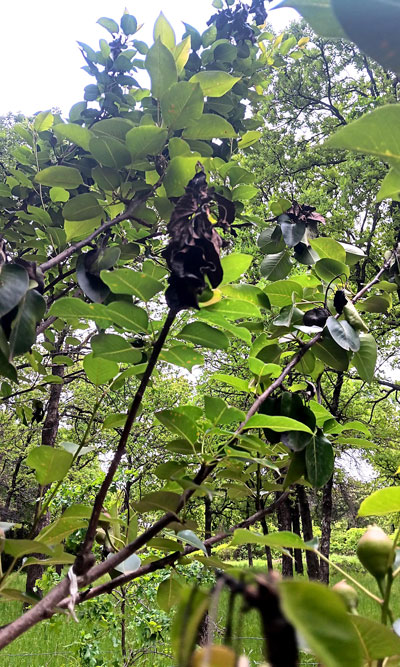
Answer: Your trees have been hit by fire blight, the bacterial bane of pears across almost all of America. If you look at the twigs closely you will see lesions where the bacteria have impacted the stem tissues. Fire blight is spread by bees during flowering. It also can be spread on pruning tools. I’ll address the two independently.
University horticulturists and plant pathologists recommend use of agricultural streptomycin spray at the time of bloom to prevent entry of the bacterium into the flowers. That spray should be made late in the day, once the bee activity has waned. Copper-based fungicides are also recommended, as pointed out in this excellent reference from Clemson University: https://hgic.clemson.edu/factsheet/fire-blight-of-fruit-trees/
All impacted tissues should be removed with pruning tools. The cuts should be made a couple of inches below the lesions, and clippers should be disinfected with rubbing alcohol between each cut. You can also use a 10-percent chlorine bleach solution, but it will cause corrosion of the cutting surfaces. Whichever you use, clean and oil your tools when you have finished for the day.
Unfortunately, fire blight is a serious threat to many members of the rose family, including not only pears, but also apples, pyracanthas, cotoneasters, loquats, and others. It’s important that you keep a vigilant eye toward the spread and control of this serious pest.
QUESTION 2
WHY IS MY ST. AUGUSTINE LOOKING BAD?
Question: We have had a lot of rain. Now my St. Augustine looks like this. It was beautiful, now the tips are dying. Is this fungus or take all? Should I treat for both? What is the treatment? Randa L., Austin.

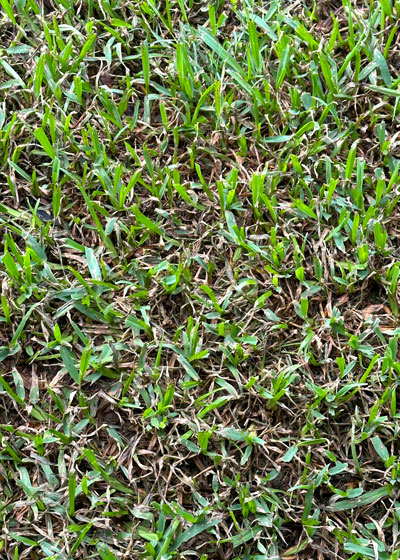
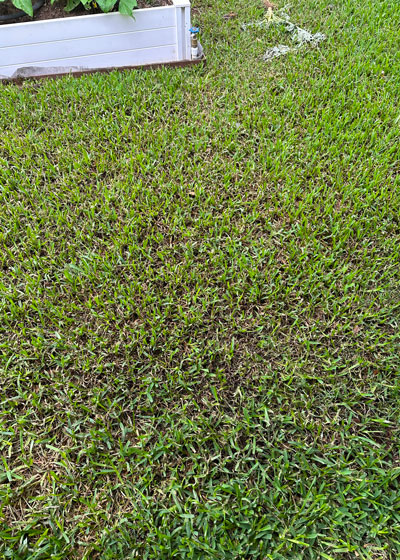
Answer: Look closely at some of the leaf blades. If you see diamond-shaped gray lesions on the blades and even the runners, that would be gray leaf spot. I can see a good many spots that I suspect are that fungus.
I also wonder if you might still have the take all root rot fungus hanging around. It’s usually a disease of the cooler weather of April going into early May. You can tell if it’s involved by digging up a few of the runners carefully. If their roots are short, bristly, and very dark, that’s TARR.
Both these diseases can be controlled with an application of Azoxystrobin fungicide, sold at the consumer level as Disease-EX by Scotts. It should be noted that gray leaf spot is a hot weather disease that is made worse by applications of nitrogen fertilizer when it’s hot. If you have fertilized recently, that would help nail down that diagnosis. You could also send samples to the Texas A&M Plant Disease Clinic for culture and diagnosis. It will cost you to have them perform that service, but that way you would know.
QUESTION 3
IS THERE ANY WAY TO TREAT FOR FUNGUS ON LIVE OAK TREES?
Question: Is there any way to treat fungus on live oak trees, or is the tree doomed if it gets the disease? Joe C., Parker.
Answer: Are you talking about oak wilt? If so, I’m going to refer you to this website for diagnosis. https://texasoakwilt.org I’ll let you do some prowling around in its outstanding information. Many people see lichens on their oaks and confuse them (harmless) with diseases. Next time, feel free to give me more details and a photo or two. If you need a certified arborist, our advertiser here in e-gardens (Arborilogical Services) specializes in oak wilt. One of their leaders has his Masters Degree in plant pathology studying oak wilt. They are very close to you.
QUESTION 4
HOW DO I CONTROL CLOVER IN MY ST. AUGUSTINE?
Question: How do I control 3-leafed clover in my St. Augustine lawn? The patch is 4 ft. x 10 ft., and it’s getting larger each year. Sterling H., Arlington.
Answer: Use a broadleafed weedkiller (containing 2,4-D) in a trigger bottle or small pump sprayer. Apply it on a cool day or late in the day before it turns beastly hot this summer. Apply it with the nozzle of the spray tank set to deliver a small droplet size and coat the leaves almost to the point of runoff. If you notice the spray beading up and running off, open the tank, put one drop of liquid dishwashing detergent in per gallon of spray, then pump, and spray again. Do not apply with a hose-end sprayer. They apply too much and would put nearby trees and shrubs at risk. Give the herbicide two or three weeks to kill the clover. If you need to respray, do so in the same manner. Do not spray when sun is hitting the turf.
QUESTION 5
WHEN AND HOW CAN WAX MYRTLES BE PRUNED?
Question: When and how can wax myrtles be trimmed? My condo association planted some in front of my home two summers ago and they have grown like weeds. It is impossible to see who might be on the other side when I go out my front door. Terry W., Dallas.
Answer: Wax myrtles are ticking time bombs in the Blackland Prairie. After 4 or 5 years they begin to lose trunks and branches without any visible insects or diseases. They just don’t like our environmental conditions. They’re native to East Texas and the more favorable soils and moisture.
But that doesn’t answer your question. You can prune wax myrtles at any time of the year, although mid-spring would not be my choice since they’ve just invested so much effort in new growth. Do it with lopping shears so you can remove one branch at a time. That will make it easier for you to reshape and resize the plants without ending up with plants that look sheared. I would think that you would have every right to do so later this month after the spring growth slows down.
QUESTION 6
WHAT IS WRONG WITH MY APPLE TREE?
Question: What is wrong with my apple tree? Its tips are turning brown. T.N., Parker, Collin County.
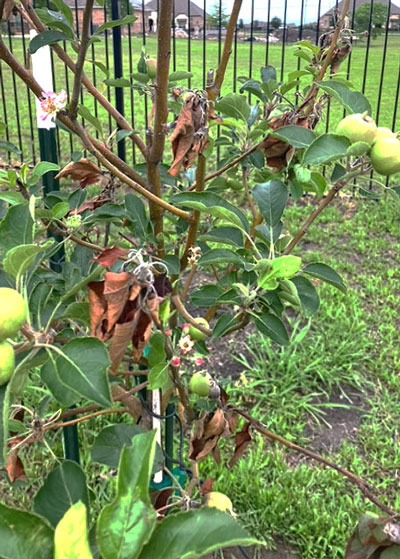
Answer: This, again, is fire blight, the bacterial infection that attacks members of the Rose Family of plants. Please see all the details in Answer 1 above. Every word will apply to your apple tree.
QUESTION 7
WHAT IS GOING ON WITH MY TOMATO PLANTS’ LEAVES?
Question: What is going on with my tomato plants’ leaves. It seems to be the bottom leaves only. The upper leaves are fine. They’re in 5-gallon pots. I know you don’t like pots that small, but it’s what I had for now. Frank G., Sanger, Denton County.

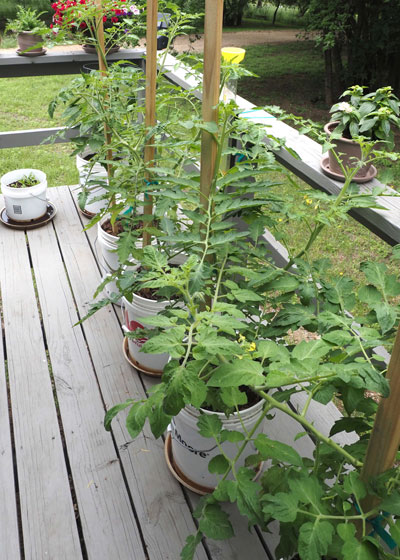

Answer: The problem with smaller containers for tomatoes is the quantity of soil and how quickly it can dry out as temperatures climb. That results in blossom-end rot in many cases – fruit that develops brown, sunken areas at the far end of the fruit where the flowers had been attached. That’s where the plant dries out first and where water is transported last (farthest from the roots). But, obviously, that’s not the problem that caused you to write this time.
I see several other things I’ll point out.
I do think that your plants have gotten too dry one or more times. And there has also very likely been a nutrient shortage causing much of the trouble with the lower leaves.
The plants are not receiving enough sunlight which is why they are stretching out beyond the short cages. Those cages are intended for northern and midwestern gardens where the growing season is much shorter.
The large brown blotches may be due to early blight, a fungal disease that shows up in cool, wet springs. Keep the foliage dry when you water and apply a labeled fungicide to slow its spread.
Watch, too, as it gets hotter, for signs of spider mites. They will turn lower leaves a mottled tan. If you thump suspect leaves over white paper, you will see the nearly microscopic pests moving about freely. They are difficult to control, but several general-purpose insecticides do list spider mites on their labels. I feel like I’ve rained on your entire parade, and I apologize for that. It was done in the spirit of trying to help. Good luck!
